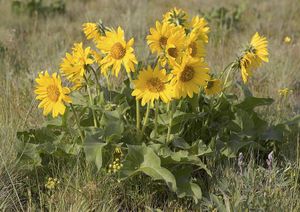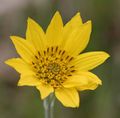Difference between revisions of "Balsamorhiza deltoidea"
(→Taxonomy) |
(→Description) (Tag: VisualEditor) |
||
| (4 intermediate revisions by the same user not shown) | |||
| Line 1: | Line 1: | ||
| − | * | + | * Scientific Name: ''Balsamorhiza'' ''deltoidea'' |
* Family: Asteraceae | * Family: Asteraceae | ||
* Common Names: deltoid balsamroot, Puget balsamroot | * Common Names: deltoid balsamroot, Puget balsamroot | ||
* Codon: BALDEL | * Codon: BALDEL | ||
| − | + | ---- | |
| − | == Taxonomy == | + | [[File:BALDEL1.jpg |thumb|Photo by Rod Gilbert, 2005. Also featured on Main Page]] |
| + | === Taxonomy === | ||
{{Taxobox | {{Taxobox | ||
| − | | image = | + | | image = |
| image_caption = Photo by Rod Gilbert, 2005. Also featured on Main Page | | image_caption = Photo by Rod Gilbert, 2005. Also featured on Main Page | ||
| − | | name = | + | | name = |
| regnum = [[Plant]]ae | | regnum = [[Plant]]ae | ||
| subregnum = Viridiplantae | | subregnum = Viridiplantae | ||
| Line 21: | Line 22: | ||
| subspecies = | | subspecies = | ||
}} | }} | ||
| − | < | + | <ref>Integrated Taxonomic Information System. Retrieved from https://www.itis.gov/servlet/SingleRpt/SingleRpt?search_topic=TSN&search_value=36808</ref> |
| − | == Description == | + | === Description === |
| − | + | Perennial herb growing from a large, resinous taproot.<ref name=":1" /> Basal leaves large, to 50 cm, long-petiolate, triangular, stiff-haired.<ref name=":0">Goodrich, A. (2012). ''Guidelines of Establishment of Seed Production Sites on Military Installations.'' Department of Defense Legacy Resource Management Program. Retrieved from https://denix.osd.mil/nr/focus-areas/habitat/habitat-restoration/reports/guidelines-of-establishment-of-seed-production-sites-on-military-installations-final-report-february-2012-legacy-10-326/</ref> Cauline leaves few, reduced, linear.<ref name=":0" /> Pseudanthia terminal, radiate, with bright yellow ray florets and darker disk florets<ref>Bowcutt, F., & Hamman, S. (2016). ''Vascular Plants of the South Sound Prairies''. p. 71.</ref> which are both fertile.<ref>Hitchcock, C. L., Cronquist, A., Giblin, D., | |
| + | & Legler, B. et al. (2018). ''Flora of the Pacific Northwest: an | ||
| + | illustrated manual''. Seattle: University of Washington Press. p. 549.</ref> Phyllaries lanceolate to oblong-lanceolate, slightly woolly.<ref name=":0" /> Ovaries inferior, becoming glabrous achenes.<ref name=":1" /> | ||
| − | + | === Bloom Period === | |
| − | + | March - July<ref name=":1">WTU | |
| − | + | ||
| − | March - July<ref>WTU | + | |
Herbarium, Burke Museum, & University of Washington. Retrieved from http://biology.burke.washington.edu/herbarium/imagecollection/taxon.php?Taxon=Balsamorhiza%20deltoidea</ref> | Herbarium, Burke Museum, & University of Washington. Retrieved from http://biology.burke.washington.edu/herbarium/imagecollection/taxon.php?Taxon=Balsamorhiza%20deltoidea</ref> | ||
| − | == Distribution == | + | === Distribution === |
| − | Pacific Coast states west of the Cascades | + | The Straight of Georgia, Pacific Coast states west of the Cascades, south to California.<ref name=":0" /> |
| − | == Habitat == | + | === Habitat === |
| − | + | Shorelines, prairies, meadows, shrub steppe and other open areas of the Puget Trough. Prefers deep soils<ref name=":0" /> and areas that are regularly burned.<ref>Native Plants of North America. Retrieved from <nowiki>https://www.wildflower.org/plants/result.php?id_plant=BADE2</nowiki></ref> | |
| − | == Uses == | + | === Uses === |
| + | Use by many First Nations including the Karok, Kawaiisu, Atsugewi and Klamath for food and medicine. Fresh peduncles and ground and often roasted seeds eaten. Decoction of root used for treatment of lung ailments.<ref>Native | ||
| + | American Ethnobotany Database. Retrieved from http://naeb.brit.org/uses/search/?string=Balsamorhiza+deltoidea</ref> | ||
| − | + | === Propagation === | |
| − | + | ||
| − | == Propagation == | + | |
Fruit and Seed Collection Shake into bag and do not crush. If the whole stem must be collected, leave several inches of stem and place head down in bag (for small lots of seed collection).<ref name=":0" /> | Fruit and Seed Collection Shake into bag and do not crush. If the whole stem must be collected, leave several inches of stem and place head down in bag (for small lots of seed collection).<ref name=":0" /> | ||
Fruit and Seed Extraction Use the Clipper seed cleaning machine with a medium amount of air flow, through either screen size combinations: 14RD and 6RD, 9RD and 6RD. Discard chaff from port #2 and drawer 3, 4, and 5. Recover the course chaff with seed that did not fall through the top screen (either 14RD or 9RD). Save the very clean seed from main drawer. Take the course chaff/seed and seed that dropped into main tray and re-run through the Clipper once or twice to ensure cleanest seed.<ref name=":0" /> | Fruit and Seed Extraction Use the Clipper seed cleaning machine with a medium amount of air flow, through either screen size combinations: 14RD and 6RD, 9RD and 6RD. Discard chaff from port #2 and drawer 3, 4, and 5. Recover the course chaff with seed that did not fall through the top screen (either 14RD or 9RD). Save the very clean seed from main drawer. Take the course chaff/seed and seed that dropped into main tray and re-run through the Clipper once or twice to ensure cleanest seed.<ref name=":0" /> | ||
| − | |||
| − | |||
=== Seed === | === Seed === | ||
| Line 76: | Line 75: | ||
'''Longitudinal Cross Section:''' elliptical [[Image:]] {{Basics}} | '''Longitudinal Cross Section:''' elliptical [[Image:]] {{Basics}} | ||
| − | == Photo Gallery == | + | === Photo Gallery === |
<gallery> | <gallery> | ||
File:BALDEL2.jpg| Photo: Rod Gilbert, 2003 | File:BALDEL2.jpg| Photo: Rod Gilbert, 2003 | ||
| Line 83: | Line 82: | ||
</gallery> | </gallery> | ||
| − | == References == | + | === References === |
<references /> | <references /> | ||
Latest revision as of 19:50, 24 June 2021
- Scientific Name: Balsamorhiza deltoidea
- Family: Asteraceae
- Common Names: deltoid balsamroot, Puget balsamroot
- Codon: BALDEL
Contents
Taxonomy
| Scientific classification | |
|---|---|
| Kingdom: | Plantae |
| Subkingdom: | Viridiplantae |
| Phylum: | Tracheophyta |
| Subphylum: | Spermatophytina |
| Class: | Magnoliopsida |
| Subclass: | Asteranae |
| Order: | Asterales |
| Family: | Asteraceae |
| Genus: | Balsamorhiza Nutt. |
| Species: | Balsamorhiza deltoidea Nutt. |
Description
Perennial herb growing from a large, resinous taproot.[2] Basal leaves large, to 50 cm, long-petiolate, triangular, stiff-haired.[3] Cauline leaves few, reduced, linear.[3] Pseudanthia terminal, radiate, with bright yellow ray florets and darker disk florets[4] which are both fertile.[5] Phyllaries lanceolate to oblong-lanceolate, slightly woolly.[3] Ovaries inferior, becoming glabrous achenes.[2]
Bloom Period
March - July[2]
Distribution
The Straight of Georgia, Pacific Coast states west of the Cascades, south to California.[3]
Habitat
Shorelines, prairies, meadows, shrub steppe and other open areas of the Puget Trough. Prefers deep soils[3] and areas that are regularly burned.[6]
Uses
Use by many First Nations including the Karok, Kawaiisu, Atsugewi and Klamath for food and medicine. Fresh peduncles and ground and often roasted seeds eaten. Decoction of root used for treatment of lung ailments.[7]
Propagation
Fruit and Seed Collection Shake into bag and do not crush. If the whole stem must be collected, leave several inches of stem and place head down in bag (for small lots of seed collection).[3]
Fruit and Seed Extraction Use the Clipper seed cleaning machine with a medium amount of air flow, through either screen size combinations: 14RD and 6RD, 9RD and 6RD. Discard chaff from port #2 and drawer 3, 4, and 5. Recover the course chaff with seed that did not fall through the top screen (either 14RD or 9RD). Save the very clean seed from main drawer. Take the course chaff/seed and seed that dropped into main tray and re-run through the Clipper once or twice to ensure cleanest seed.[3]
Seed
[[Image:]] Seed sample from: 2011
Average Measurement: 7.5 x 2.5 x 1.9
Measurement Range: L: 6.5 – 8.2, W: 1.6 – 4.5, D: 1.6 – 2
Features
Shape: Seed shapes have lots of variation. Some squared off, and some three sided. Most seeds narrower at hilum than at opposite apex, but not always. Hilum wrinkled. Seeds have circular, white protrusion at apex opposite hilum.
Color: Seeds black, brown, or tan, with white or tan hilum.
Surface: Seeds have some longitudinal ribbing, and are smooth and matte.
Latitudinal Cross Section: some squared [[Image:]], some triangular [[Image:]]
Longitudinal Cross Section: elliptical [[Image:]]Basic Explanations and Assumptions:
The dimensions for the seeds are length x width x depth. The location of the hilum is used as the base of the seed, and the length is measured from hilum to the opposite apex. Where a style is present, the length is measured from the hilum to the bottom of the style. Width is measured at a right angle to the length at the widest part. Depth is measured at a right angle to the intersection of height and width lines.
Measurements included are the mean average for each measurement of ten separate seeds.
All measurements in millimeters unless otherwise noted.
Photo Gallery
References
- ↑ Integrated Taxonomic Information System. Retrieved from https://www.itis.gov/servlet/SingleRpt/SingleRpt?search_topic=TSN&search_value=36808
- ↑ 2.0 2.1 2.2 WTU Herbarium, Burke Museum, & University of Washington. Retrieved from http://biology.burke.washington.edu/herbarium/imagecollection/taxon.php?Taxon=Balsamorhiza%20deltoidea
- ↑ 3.0 3.1 3.2 3.3 3.4 3.5 3.6 Goodrich, A. (2012). Guidelines of Establishment of Seed Production Sites on Military Installations. Department of Defense Legacy Resource Management Program. Retrieved from https://denix.osd.mil/nr/focus-areas/habitat/habitat-restoration/reports/guidelines-of-establishment-of-seed-production-sites-on-military-installations-final-report-february-2012-legacy-10-326/
- ↑ Bowcutt, F., & Hamman, S. (2016). Vascular Plants of the South Sound Prairies. p. 71.
- ↑ Hitchcock, C. L., Cronquist, A., Giblin, D., & Legler, B. et al. (2018). Flora of the Pacific Northwest: an illustrated manual. Seattle: University of Washington Press. p. 549.
- ↑ Native Plants of North America. Retrieved from https://www.wildflower.org/plants/result.php?id_plant=BADE2
- ↑ Native American Ethnobotany Database. Retrieved from http://naeb.brit.org/uses/search/?string=Balsamorhiza+deltoidea




